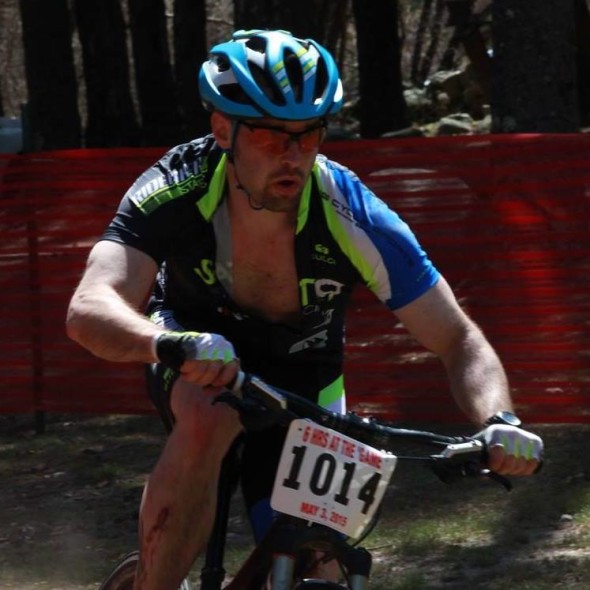
State 9 Racing’s Adam Dodge fights through the sixth hour of Burlingame in Rhode island, to earn a top 20 finish on the day. May 2015
If bike racing is all about who can suffer the most, then asking your body to work beyond the point of comfort in order to stay with a lead group becomes a requirement. Like the pistons of a car motor, your legs must continue moving up and down to push the pedals while your mind ignores the cry of your muscles to stop.
Despite your heart pounding and moving up into your throat, your mind has to ignore your body’s pleas and continue sending signals to keep working at that same level of effort. Your mind is the key component to this and critical to any success you’ll achieve.
It’s all About Mental Toughness
You can follow a training plan perfectly and prepare your body well, but if your mind hasn’t been trained to manage the pain, failure is likely. This is simply about mental toughness. If you give in too easily and stop, or want some strategies to use when you can’t quit, read on.
As cyclists, we all know the feelings that occur as the pace goes from moderate to more intense. When the workload becomes painful and the body wants to stop, we start searching within ourselves for the moment when we will give in.
Some days we can stick it out a little longer than others, but eventually we reach the point where we make the decision to pull off and slow down. Physically it feels good, but mentally we know we need to be stronger and be able to hold on longer before easing up.
Pain as a Trigger
Consider this: Instead of your mind being either on or off — or in other words, instead of mindlessly following the group or maintaining an effort level in which your body asks your mind for permission to stop — involve your mind much earlier. Do this by using the discomfort or pain as a trigger for several strategies.
In the book Sport Psychology for Cyclists, the authors suggest several strategies that I believe work well. Below I’ve summarized them into my own words, but I still suggest you read the book. You might only find one or two strategies that work well for you, but I strongly encourage you to experiment with them right now.
Tempo work is a grueling, grind of a workout. It tests not only your dedication to becoming stronger, but your desire and ability to suffer (though there is more intensity to follow). The following suggestions are ideal for testing and implementing during tempo work. Try them and I’m sure you’ll find them useful on the road and helpful when it’s time to hammer.
Strategy #1: Breathing
In the book, the authors have extensive descriptions and exercises for getting in touch with the flow of your breathing, so I encourage you to read it. However, for our purposes here, I’ll keep it very simple: Control your breathing to stay relaxed.
When we start dealing with discomfort and pain, we tense up. If you have tense muscles and posture, then valuable energy is going to waste. It takes energy (precious ATP) to contract your muscles. Tight and tense muscles use energy, leaving less available for your legs. The ability to stay relaxed when it gets difficult is paramount
Imagine yourself riding up a gentle grade at a moderate pace. Gradually the hill’s grade increases from two percent to maybe four percent. You, being dedicated to your training, work to maintain the same pace. So if you were going 16 mph up the two percent grade, you’re working harder to go 16 mph up the four percent section.
Naturally your heart rate is increasing and your legs are loading up. You know you’ll have to slow down eventually, but you want to see how long you can maintain this pace. The moment you start thinking about the discomfort is when you should start employing tactics to stay relaxed.
Focus on your breathing and upper body. Your arms and shoulders need to be loose and relaxed so you’re not wasting energy being tense. Then work on controlling your breathing with full and paced breaths. Suck the air deep into your lower lungs and out again. The speed of your breaths will continue to rise, but you’ll immediately find that some of the pain dissipates, either because you’re no longer paying attention to the pain in your legs or because they’re getting more oxygen.
Eventually you’ll cross the ventilatory threshold, the point at which your body can’t exchange the carbon dioxide built up, and your nervous system will involuntarily cause you to pant. Up until that point you’ll be able to control the air flow.
In a phenomenon that occurs during difficult moments, some individuals leave their body — so to speak. When the pain grows and the suffering begins, their mind tries to close itself off to the stimulus of suffering and simply sends out the signals to the body to continue working.
People who can do this might start focusing on something other than cycling or focusing on something up the road as a target. If you can learn to do this, it is another way to deal with the suffering. To get started, begin by focusing heavily on your breathing.
Silly? Close your eyes and picture yourself riding on an open road into a head wind. First imagine yourself configuring an energy aura around you into a large flat-faced semi-truck plowing its way into the wind. The large frontal surface area is blasted by the oncoming air and has to fight its way through, taking up valuable energy.
Now picture an energy force around you moving into a shape similar to the starship’s front, helping you slide through the wind. You move into an aero position while the starship pierces the air in front of you, clearing the wind to let you move through with little effort.
These are two possible ways you can visualize an energy source that surrounds you on the bike. If you’re skeptical, try both and see what it feels like. I’m willing to bet you’ll see a difference in how you feel. The real benefit is the ability to use visualization as a tool to take your mind off the pain and allow you to continue working at a level above what you’d normally be able to do.
Strategize and Practice
Spend some time thinking about these strategies before your next workout. What power words would energize you and what imagery would they trigger? In what way can you configure the energy around you to pierce the wind and let you slip through?
Practice focusing on your breathing when the pace gets difficult and work on staying relaxed yet strong. Experiment with these three strategies as you begin to struggle with longer intervals of tempo or other types of efforts.
Like anything else, these take some practice and polishing to use effectively. The more you implement them, the quicker you’ll know how to trigger them and benefit from them when you need help the most. If you want to do well in races or in life, you have to build mental toughness. You have to learn to overcome the suffering that both cycling and life will dish out.
For more information on subjects related to endurance training or for any of your coaching and training needs check out Marlon and the rest of the coaches from the Peaks Coaching Group at www.peakscoachinggroup.com.

























